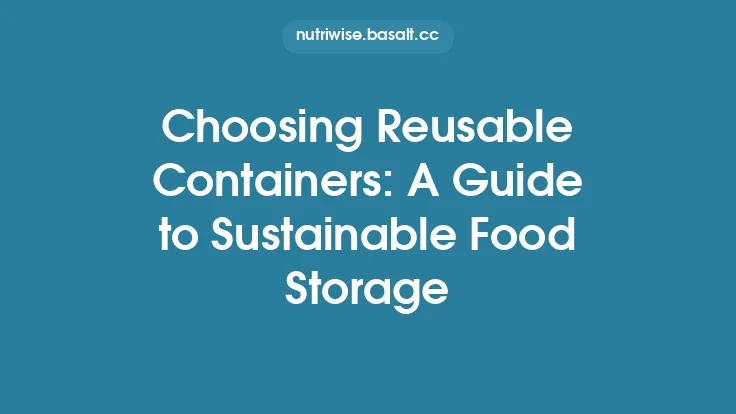Transitioning to a plastic‑free pantry is more than a one‑off swap; it’s a systematic shift in how you purchase, store, and manage food at home. By breaking the process into clear, manageable steps, you can replace plastic without feeling overwhelmed, keep your food safe, and build habits that last. Below is a comprehensive, step‑by‑step guide that walks you through every phase of the transition, from the initial audit of what you already have to the ongoing maintenance that ensures the pantry stays plastic‑free for the long term.
Assessing Your Current Pantry
- Inventory Everything
- Pull out every item, from bulk bins to pre‑packaged snacks. List the product, its packaging type (e.g., PET bottle, shrink‑wrap, foil), and the quantity you have on hand.
- Use a spreadsheet or a simple notebook; include columns for “Current Packaging,” “Quantity,” and “Potential Replacement.”
- Identify High‑Impact Items
- Focus first on items that make up the bulk of your plastic waste: bottled sauces, cereal boxes with plastic liners, single‑serve snack packs, and pre‑sliced cheese.
- Rank them by volume and frequency of use. This ranking will guide where you should prioritize replacements.
- Check Expiration Dates
- Separate anything that is close to expiring. This prevents waste while you’re in the middle of the transition and gives you a clear picture of what truly needs to be restocked in plastic‑free packaging.
- Map Storage Zones
- Sketch a quick layout of your pantry shelves, noting where each category (cereals, canned goods, spices, etc.) resides. Understanding the physical flow helps you plan where new containers will fit.
Setting Clear Plastic‑Free Goals
- Define Scope and Timeline
- Decide whether you want a complete overhaul (all items) or a phased approach (e.g., “All dry goods within six months”).
- Set realistic milestones, such as “Replace all pantry staples by the end of the quarter.”
- Quantify Reduction Targets
- Translate your goals into measurable numbers: “Reduce plastic packaging by 75 % (by weight) in the pantry within 12 months.”
- Use the inventory data to calculate baseline plastic weight; track progress monthly.
- Align with Household Priorities
- Discuss the plan with family members or housemates. Ensure everyone understands the why and the how, and gather input on any constraints (e.g., budget, dietary needs).
Researching Viable Alternatives
- Material Characteristics
- Glass: Non‑porous, inert, and impermeable to gases, making it ideal for dry goods, liquids, and items that benefit from airtight sealing.
- Stainless Steel: Durable, resistant to corrosion, and lightweight compared with glass. Works well for bulk storage of grains, nuts, and powders.
- Food‑Grade Silicone: Flexible, heat‑resistant, and sealable. Useful for lids and collapsible containers.
- Ceramic or Enamel: Good for storing spices and herbs; they provide a barrier against moisture and light.
- Compatibility with Existing Shelf Space
- Measure the interior dimensions of your pantry shelves. Choose containers that maximize vertical space without causing instability.
- Safety and Compliance
- Verify that any alternative container is certified food‑grade (e.g., FDA‑approved for glass, BPA‑free for silicone). This ensures no leaching of chemicals into food.
- Lifecycle Considerations
- Look for products with a long service life and repairability. A container that can be repaired (e.g., replace a silicone seal) reduces future waste.
Creating a Replacement Timeline
- Phase 1 – Core Staples
- Target items you use daily: flour, sugar, rice, pasta, oils, and condiments. Replace these first because they have the highest turnover and will quickly showcase the benefits of a plastic‑free system.
- Phase 2 – Secondary Items
- Move on to less‑frequent items such as specialty spices, baking powders, and snack foods. These often come in smaller packages, so you can experiment with different container types.
- Phase 3 – Seasonal and Occasional Goods
- Finally, address items that appear only a few times a year (e.g., holiday treats, specialty sauces). By this stage, you’ll have a solid system in place for integrating new items.
- Buffer Periods
- Allow a 2‑week buffer between phases to assess any issues (e.g., fit, sealing performance) and make adjustments before moving on.
Sourcing Sustainable Materials
- Local Bulk Stores and Co‑ops
- Many bulk retailers allow you to bring your own containers. This eliminates the need for pre‑packaged plastic and often offers lower prices per unit.
- Specialty Kitchenware Brands
- Look for manufacturers that focus on durability and repairability. Brands that provide lifetime warranties are a good indicator of long‑term sustainability.
- Second‑Hand Marketplaces
- Platforms like local classifieds, thrift stores, and community swap groups can be treasure troves for high‑quality glass jars and stainless‑steel containers at reduced cost.
- Direct‑From‑Manufacturer Options
- Some producers sell bulk containers (e.g., 5‑liter glass canisters) directly to consumers, bypassing retail packaging altogether.
- Cost‑Benefit Analysis
- While upfront costs may be higher, calculate the long‑term savings by factoring in reduced repeat purchases of disposable packaging and potential bulk‑price discounts.
Organizing the Plastic‑Free Pantry
- Standardize Container Sizes
- Choose a limited set of container dimensions (e.g., 1 L, 2 L, 5 L) to create visual uniformity and simplify stacking.
- Labeling System
- Use reusable labeling methods: chalkboard stickers, laser‑etched tags, or silicone labels that can be wiped clean. Include the product name, purchase date, and best‑by date.
- Zoning by Food Category
- Allocate specific shelves for grains, legumes, baking supplies, and condiments. This reduces the time spent searching and minimizes the chance of misplacing items.
- Airflow and Light Management
- Store light‑sensitive items (e.g., spices, oils) in opaque containers or in the lower sections of the pantry to protect them from UV exposure.
- Safety Considerations
- Ensure heavy glass containers are placed on lower shelves to prevent accidental toppling. Use non‑slip mats under containers that may become slick when wet.
Implementing Bulk‑Buying Strategies
- Calculate Optimal Purchase Quantities
- Use your consumption data (e.g., average monthly usage of rice) to determine the ideal bulk amount that balances freshness with reduced packaging.
- Rotate Stock Using the “First‑In, First‑Out” (FIFO) Method
- Place newly purchased items behind older ones. This simple visual cue helps prevent waste due to expired goods.
- Leverage Community Bulk Buying
- Partner with neighbors to place larger orders that qualify for bulk discounts, then split the goods and share the reusable containers.
- Track Inventory Digitally
- Apps or simple spreadsheet formulas can alert you when a product is nearing its best‑by date, prompting timely usage or donation.
Establishing Refill and Return Systems
- Create a Refill Station
- Designate a small countertop area with a few clean, empty containers ready for refilling. Keep a set of cleaning brushes and a mild, food‑safe sanitizer nearby.
- Partner with Local Suppliers
- Some grocery stores and specialty shops offer refill stations for items like oils, vinegars, and dry beans. Establish a routine visit schedule.
- Implement a Return Loop for Non‑Reusable Items
- For occasional purchases that still come in plastic (e.g., a specialty sauce), set up a system to collect the empty packaging for recycling or upcycling, ensuring it doesn’t re‑enter your pantry.
- Document Refill Dates
- Write the refill date on the container label. This helps you monitor how long a product has been stored and maintain freshness.
Maintaining the Plastic‑Free Standard
- Regular Audits
- Conduct a quick visual check every month. Verify that all items are in approved containers and that labels are legible.
- Cleaning Protocols
- Establish a routine for sanitizing containers: wash with hot, soapy water, rinse thoroughly, and air‑dry. For glass and stainless steel, a brief dip in a diluted vinegar solution can help remove residual odors.
- Education and Reinforcement
- Keep a small “cheat sheet” in the pantry that outlines the key steps for new household members or guests who might inadvertently bring in plastic packaging.
- Adaptation to New Products
- When you encounter a new food item, assess whether it can be transferred to an existing container or if a new type of container is needed. This prevents the accumulation of single‑use containers.
Measuring Success and Adjusting the Plan
- Quantitative Metrics
- Track the weight of plastic avoided each month. Compare it against your initial baseline to see if you’re meeting the reduction targets.
- Qualitative Feedback
- Gather input from everyone using the pantry. Are the containers convenient? Is food staying fresh? Use this feedback to tweak container choices or organization.
- Financial Review
- Review grocery receipts and compare the cost per unit before and after the transition. Factor in savings from bulk purchases and reduced waste.
- Iterative Improvements
- Based on the data, adjust your timeline, explore new container technologies, or refine your labeling system. The transition is a living process, not a static checklist.
By following this structured, step‑by‑step approach, you can systematically eliminate plastic from your pantry while preserving food quality, maintaining convenience, and fostering sustainable habits that extend beyond the kitchen. The key lies in planning, incremental change, and continuous evaluation—ensuring that the plastic‑free pantry becomes a lasting part of your lifestyle rather than a temporary experiment.





